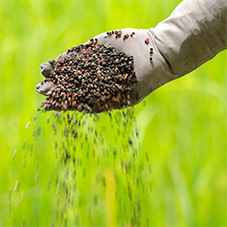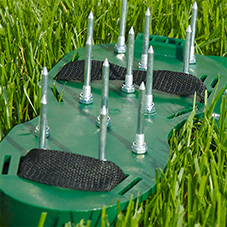Lawn care
 Irrigation
Irrigation
How often the lawn should be watered? There is no clear answer. Grass demand for water depends on many factors, including seasons, topography, soil type and maturity of the lawn. One thing is certain: in order to ensure a good condition of our turf, it is necessary to use artificial irrigation.
3-4 weeks after sowing, an extreme care should be given to ensure constant substrate moisture. For this purpose, preferably use a spray setting the program of very fine drops of water. As a result, the seeds will not be uncovered and will not move.
Mature lawns should be watered less often, but more abundantly. To make the root system develop properly, the method of controlled drying of turf can be used. In this way the grass is stimulated to seek water deeper. After drying the soil to approx. 5 cm, watering should be resumed.
Remember! Too frequent and abundant irrigation can cause rotting and shortening of the root system. An additional use of nitrogen-rich fertilizers at this time creates ideal conditions for the development of fungal diseases. Grass growing in such conditions does not tolerate frosts and droughts well, so it is worth noting that sometimes less is more.
 Mowing
Mowing
Mowing is a very important care treatment. The frequency depends on several factors, including, among others, the selected mixture, fertilization program and the season. The main thing is that it should be a systematic activity. As a result, the grass will not gather in clumps and its intensive development, propagation of leaves and brevity will be plainly visible.
The lawn should be mowed for the first time when it reaches the height of 10 cm. Then we shorten it to 4-5 cm. Subsequent cutting can be carried out lower, as indicated for the particular mixture. To make the work effective, the surface should be dry and the blades properly prepared. This will protect our lawn against unnecessary damage to the leaves and the root system ensuring a beautiful look of the turf.
Remember! The biggest daily growths are observed in May and August. This is the period in which even more attention should be paid to regular mowing. Especially vigilant should be the owners of mixtures with faster growing grasses.
 Fertilization
Fertilization
Is there a need to fertilize the lawn? This is one of the most important factors supporting the normal development of the turf. Macro- and micronutrients delivered in this way have a positive influence on the root system and the propagation of grasses. This is particularly important in the initial growth phase when undesirable plants are natural competitors to sensitive shoots.
Fertilization should be applied from the beginning of vegetation until the end of August. How often? It depends on the type of formulation. Some should be applied several times, others one or two times during the season. It is very important not to exceed the maximum dose. What dose, then, is right? It is best determined based on an analysis of the nutrient content in the soil. The fertilization program prepared on this basis will certainly be the most effective way to perfectly nourish the grass.
Remember! Fertilizers are not natural products, which is why you should choose them wisely. Failure to follow the manufacturers’ instructions may cause adverse effects, even the need to replace the turf.
 Aeration and scarification
Aeration and scarification
Aeration is a care treatment used to aerate the surface layer of the soil. It is conducive to the growth of root mass and the emergence of new runners. What is it about? Sharp-edged pipes placed on a garden roll punch holes with a diameter of 15-20 mm in the soil penetrating the earth to a depth of approx. 8 cm. When aeration should be used? It may be performed several times a year, but the most important moment is the beginning of the grass growing season. It then accelerates the regeneration of the lawn after winter.
Scarifying is a more invasive treatment, which is why it should be applied to at least 2-year old lawns. It involves a vertical, shallow cutting of the sod to provide a better flow of water and air as well as to cause a more effective impact of the fertilizer. During scarifying felt is removed, which stimulates plants to strong propagation and faster recovery. This treatment can be performed several times a year, starting from early spring. It should be noted that the grass should be previously mowed and the ground should be dry. After the work is done, all dead plant debris should be collected.
Remember! In order to complete losses incurred during aeration or scarifying, sanding should be carried out.

